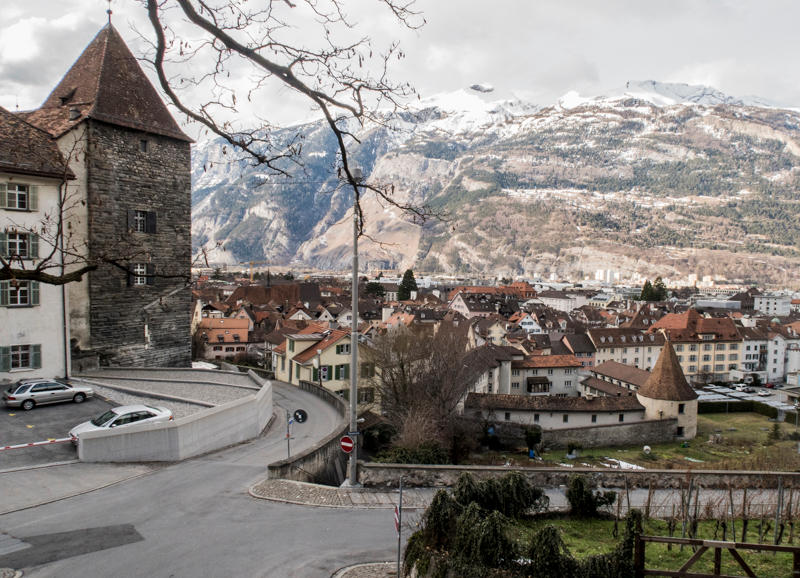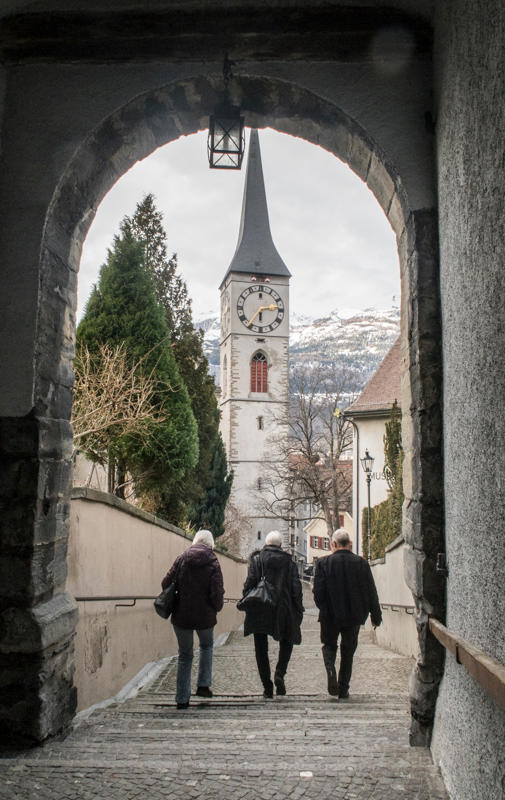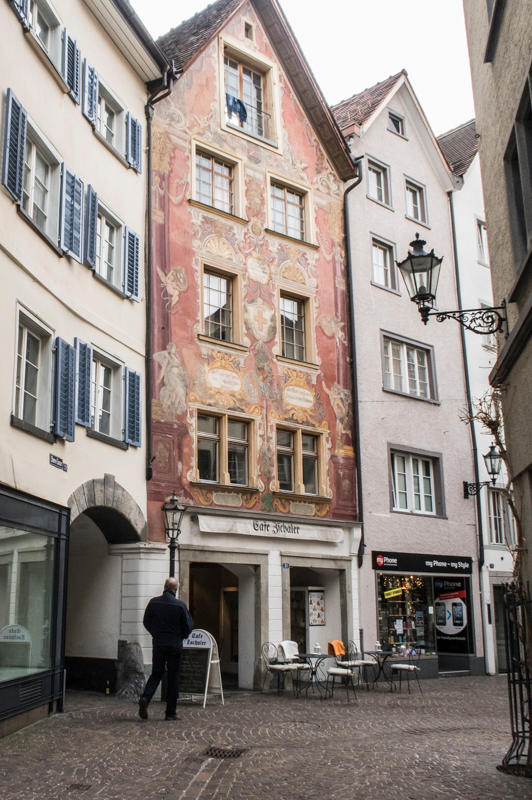Is Swiss town Chur one of world’s oldest?

The Swiss town of Chur claims it’s at least 11,000 years old. If true, that would make it as old or older than Jericho in the Middle East, accepted as one of the earliest continuous settlements in the world. Can the Chur claim hold up?
A suggestion to first-time visitors to the old part of the town in eastern Switzerland: Leave your map in your pocket and get a little lost. Wander the winding cobblestone lanes (no cars allowed) and you’ll soon stumble upon superbly preserved old buildings with richly detailed painted façades, hidden courtyards, ornate doors and clocks, and the stalwart 15th-century St Martin’s Church (stained glass by Augusto Giacometti).
There are also fascinating historical exhibits in the Rätisches MuseumExternal link (yes, there’s a crossbow) plus plenty of little cafés, boutiques and hotels. The oldest buildings date from after the great fire of 1464, which destroyed most of the town.
But Chur (first two letters pronounced like a guttural ‘k’) is much older, according to the tourist boardExternal link. That’s because, in 1998, construction workers excavating for a car park uncovered archaeological artifacts dating back to about 11,000 BCE. This is why Chur has been frequently described as “the oldest city in Switzerland”, and would make it some 2,000 years older than Jericho.

But in the town of Neuchâtel – at nearly the opposite, western end of the country – archaeologists have found artifacts dating to about 13,000 BCE, some 2000 years older than those in Chur. Even so, humble Neuchâtel officially claims to date back only to 1011, from the first known written mention of the town of “Novum Castellum”, Latin for “Neuchâtel” (“New Castle”).
Does either Chur or Neuchâtel – or another Swiss town – deserve bragging rights as the oldest? And can it challenge Jericho?
It’s true that “Chur has certainly yielded some of the oldest archaeological finds in Switzerland”, says Professor Philippe Della Casa from the Institute for Archaeology at the University of Zurich. But they “belong to temporary camp sites, not to sedentary settlements”.
To be called a “town”, certain criteria must be met, says Della Casa, including “centralized administration, complex planning and architecture, structured social organisation and specialised crafts”. By these criteria, “Chur is certainly not the ‘oldest town’ in Switzerland, since towns as such do not emerge before the Celtic Iron Age, the mid-first millennium BCE”.
Similarly, the earliest Neuchâtel shoreline artifacts are from “nomad camps of hunter-gatherers”, says Marc-Antoine Kaeser, Professor of Archaeology at the University of Neuchâtel and Director of LaténiumExternal link. Laténium is Switzerland’s largest archaeological museum. It stands by Lake Neuchâtel near where the oldest artifacts were found. In the archaeology park just outside the museum’s doors stand replicas of Neolithic lake dweller houses from 3810 BCE. Inside, Laténium’s exhibits trace 500 centuries, beginning with the Neanderthals.

Kaeser says the oldest permanent Neolithic settlements so far identified in Switzerland were in the Rhone valley and in the town of Bellinzona on the south side of the Alps. But “a real continuous occupation can only be attested from the Roman times on”.
Professor Della Casa suggests we look to Zurich, Bern, Geneva or BaselExternal link as our oldest towns. “All these sites had fortified Celtic settlements in the second half of the first millenium BCE,” he says.
Thomas Reitmaier concurs with this timeline. Director of the Archaeological Service for canton Graubünden, Reitmaier’s office is in Chur. “This is quite tricky,” he says, but “generally the emergence of the earliest proto-urban and urban centres north of the Alps are dated to the first Millenium BCE”.
Therefore he adds it’s “difficult to determine the oldest Swiss town.”
What about Chur?
“It seems clear: there are first late-Paleolithic Period (about 12,000 BCE) remains of some camps, and some first settlements from the Neolithic Period (4,500 BCE) onwards, till the Roman occupation and the founding of a rather small vicus [an ancient Roman settlement]”. But Reitmaier says “we should talk about the town of Chur from the medieval period at the earliest,” noting that the town walls weren’t constructed until the 13th century.
Interesting facts to contemplate as you stroll old Chur’s indisputably enchanting cobblestone lanes.
Maybe the Swiss town is just coming into its prime.

In compliance with the JTI standards
More: SWI swissinfo.ch certified by the Journalism Trust Initiative











You can find an overview of ongoing debates with our journalists here . Please join us!
If you want to start a conversation about a topic raised in this article or want to report factual errors, email us at english@swissinfo.ch.